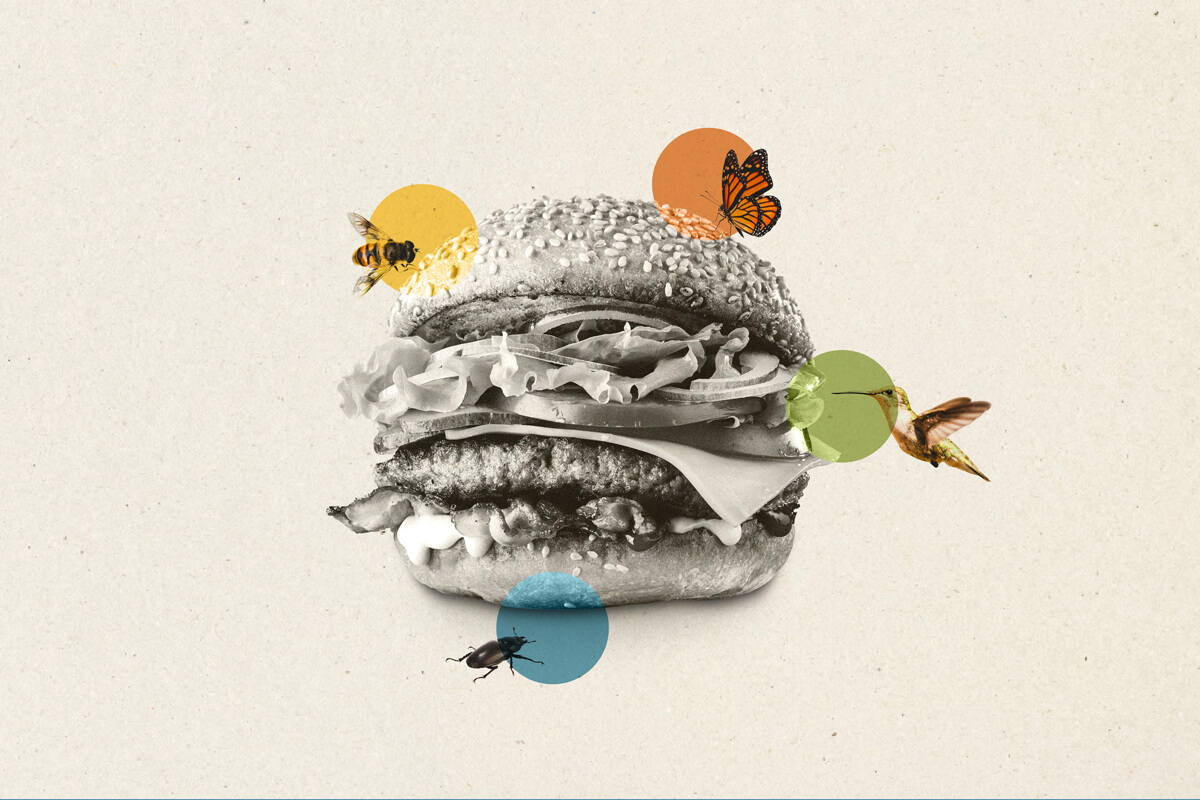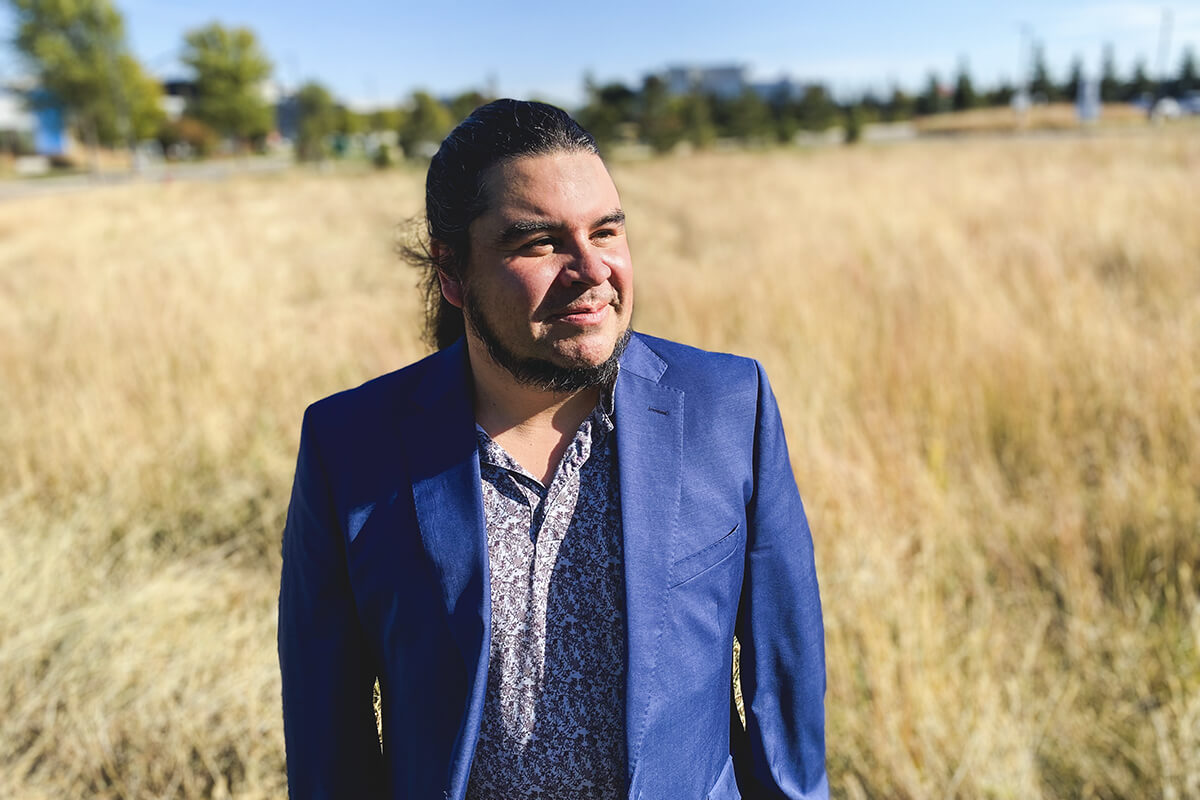
Why Are Pollinators Key to Year-Round Food Security?
The next time you’re chomping down on a burger with all the fixings or a big salad—or any meal, really—remember to savour this stat: about one out of every three bites of food you take exists because of pollinators.
That’s because about 35 per cent of the world’s food crops depend on little creatures like bees, butterflies, birds and beetles to reproduce.
In other words, without all of those pollinators unknowingly depositing pollen from plant to plant in their search for food, the food we eat would be a lot more limited, says Kyle Bobiwash, an Assistant Professor and Indigenous Scholar in the Department of Entomology at UM.
“If you only eat bread, well you don’t really have to thank pollinators because crops like wheat and corn don’t need pollination from animals,” he says. “But if we’re thinking about most people and their food security and having a much more balanced diet with milk, meat, fruits, nuts, all these other components, well then yes, you’re very reliant on pollinators.”
The problem is that there are big questions around the future—and even the current—state of those pollinators and therefore the future of food security, says Bobiwash, whose work focuses on understanding the ecology of beneficial insects in agroecosystems and the greater landscape.
Take bees, for example. While honey bees garner much of the attention through fears of colony population loss, the wild bee population remains uncertain and unknown. And any impact on food supply could vary widely from region to region depending on how reliant they are on pollinator species for their production.
“When we think of those in the global south or areas with poor food distribution, for instance, places like southern Africa and Southeast Asia or even northern Canada, a lot of people in more remote areas tend to heavily rely on wild harvested resources like berries that are very dependent on pollinators,” says Bobiwash.

Kyle Bobiwash // Photo by Katie Chalmers-Brooks
There is a lot of data around pollinator changes in richer countries, but that’s not necessarily true in areas like the tropics, where ecosystems are changing the fastest from climate change, or even in these more remote areas of Canada. Pollinators in these regions could be doing worse than we think.
The solution? Bobiwash is trying to fill that pollinator data hole here in Canada through fieldwork, with visits to UM’s research stations, as well as other research sites near Brokenhead Ojibway Nation and into Ontario, along with various roadsides and farm edges across Manitoba.
“The thing that I think is most important right now is just understanding what pollinators are in these landscapes—whether it’s farm landscapes, natural landscapes—and understanding what are the potential drivers for their diversity,” he says.
Once land managers and farmers have this targeted understanding of what’s happening in their areas, then they can support pollinator diversity and health in a number of ways, says Bobiwash.
They can, for instance, create or maintain areas adjacent to farms that have year-long floral blooms and stable habitats for pollinators. They can maximize functions of the landscape that best support pollinators, such as plant production or flood mitigation. They can also take a systems perspective to benefit specific pollinators, which could mean thinking about things like soil conditions.
In short, researchers and land managers have to try to “see through the eyes of pollinators,” says Bobiwash.
“Once we do that and once we start prioritizing the elements of a landscape that are important for the maintenance of those species, then we’ll start to see more resilient or even more diverse pollinator communities.”
HOW TO INTEGRATE INDIGENOUS PERSPECTIVES IN YOUR WORK
An Indigenous Scholar in the Department of Entomology and a proud member of Mississauga First Nation, Kyle Bobiwash says Indigenous science isn’t all that different than traditional Western science. The main differences are about values.
“Indigenous science is much more focused on making sure that you’re maintaining the integrity of relationships,” he says. “Like maintaining the integrity of the relationship between a pollinator and its plant, for example, than it is trying to utilize that relationship as a human resource.”
Here, Bobiwash offers up two questions to ask yourself if you want to integrate Indigenous perspectives in your work:
1. Why do you want to integrate? “It can’t just be because it’s a hot topic or because a government agency is asking for it. You really have to understand the value that your project is going to bring to Indigenous people. To do that kind of weaving of knowledges well, you have to do it as a way to answer questions that are relevant to Indigenous people locally, that are driving things like food sovereignty, self determination, reestablishing cultural practices. And you have to do this thinking at the outset, at the beginning of your planning.”
2. Who have you talked to? “It’s also so important to talk to Indigenous people during that planning. If you haven’t created any relationships with Indigenous people, leaders, communities, nations, you have no chance and probably no actual business of doing a lot of that work. It’s not just a simple thing of having a new Indigenous partner as part of your grant, for example. You have to get out there and actually speak to people, understand what’s relevant to them.”






